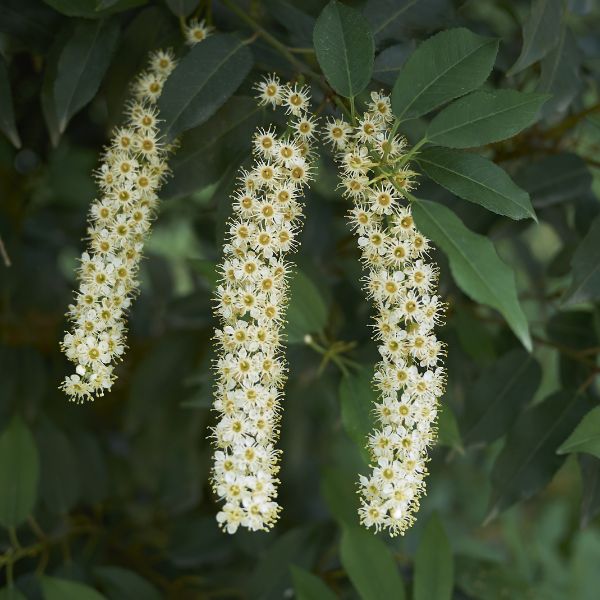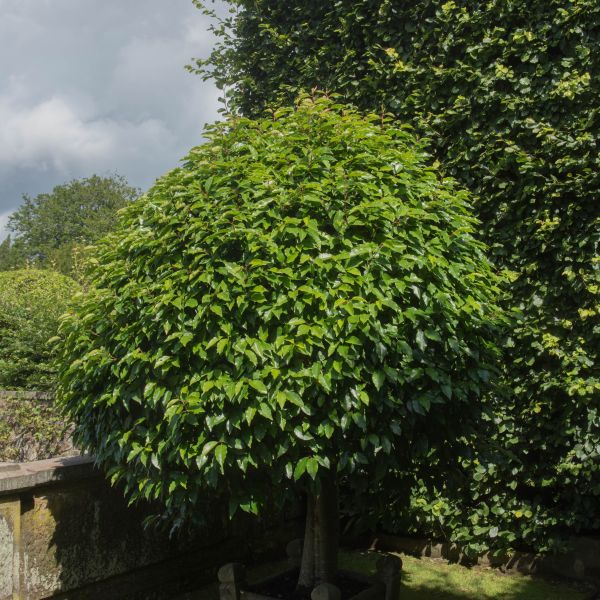


Portuguese Laurel
Prunus lusitanica
86 reviews
Portuguese Laurel
Prunus lusitanica
86 reviews
- Tolerant of various soil types
- Low maintenance plant
- Attractive glossy evergreen foliage
- Recommended by landscape designers for optimal fit in real yards
$150.00
$215.00
30% Off
- Ships to in 7-10 Days
- Free Shipping
- Plant Arrival Guarantee
- In Stock
- Free Plant Consult
$200 - Landscape-Approved: Every Plant We Sell Comes With Design Expertise Behind It
- 3.5 Gallon
- 1 Gallon
We are sorry, product is currently out of stock due to seasonal availability. Please check the "Related plants available in your area" section below
Not just beautiful - intentionally selected by ShrubHub's 3D landscape design team to fit real-world spaces and maximize yard potential.
Why Portuguese Laurel?
Portuguese Laurel (Prunus lusitanica) is a popular choice for hedges and screening due to its dense foliage and ability to tolerate pruning. This evergreen shrub features glossy green leaves and produces small white flowers in early summer, followed by red berries. It can grow in full sun to partial shade and is relatively low-maintenance, making it a desirable option for gardeners.
Sunlight
Portuguese Laurel (Prunus lusitanica) prefers full sun to partial shade, although it can tolerate some shade. It typically thrives in areas with at least 4-6 hours of direct sunlight per day.
Watering
Portuguese Laurel requires regular watering, especially during dry periods, to keep the soil consistently moist. It is important to provide sufficient water, ensuring the root ball is well hydrated, but avoid overwatering as it can lead to root rot.
Fertilizing
Portuguese Laurel requires a balanced fertilizer with equal ratios of nitrogen (N), phosphorus (P), and potassium (K). The specific nutrient requirements may vary, but a complete fertilizer with an NPK ratio of 10-10-10 or 14-14-14 is generally recommended
Portuguese Laurel (Prunus lusitanica)
The Portuguese Laurel, scientifically known as Prunus lusitanica, is an evergreen shrub native to Portugal and Spain. It belongs to the Rosaceae family, which is known for its attractive and popular flowering plants. The Portuguese Laurel is widely appreciated for its versatility and ornamental value.
Appearance
This shrub typically grows up to 10-20 feet tall and wide, forming a dense, bushy habit. It features glossy, dark green leaves that are ovate or lanceolate in shape. The foliage emits a pleasant, aromatic fragrance when crushed or brushed against. The stems are reddish-brown and become more prominent as the plant matures.
Flowers
In late spring or early summer, the Portuguese Laurel produces clusters of small, fragrant white flowers that adorn the branches. These flowers are arranged in upright panicles and make a delightful addition to any garden or landscape. They attract pollinators such as bees and butterflies, adding to the biodiversity of your outdoor space.
Fruits
Following the blooming period, the flowers give way to small, round berries. These berries start off green but gradually turn from red to black as they ripen. While the berries are not typically consumed by humans, they are attractive to birds, making the Portuguese Laurel a wonderful choice for wildlife-friendly gardens.
Uses
The Portuguese Laurel is a versatile plant that can be utilized in various ways. Due to its dense foliage, it works excellently as a privacy hedge, providing a natural boundary between properties. It can also be shaped into beautiful topiaries or used as a foundation planting around buildings or fences. Additionally, the ornamental features of the Portuguese Laurel make it suitable for border plantings, formal gardens, or even as a standalone specimen.
Growth Requirements
This evergreen shrub thrives in full to partial sun, although it can tolerate some shade. It prefers well-drained soil that is rich in organic matter. Portuguese Laurel is known for its adaptability to different soil types, including clay, loam, or sand. Once established, it is relatively drought-tolerant but benefits from regular watering during dry spells, especially in the first few years of growth.
The Portuguese Laurel is generally hardy and can withstand cold temperatures once mature. However, it may require protection from severe winter winds in colder regions. Pruning is usually done in late summer or early autumn to maintain a desired shape or size and encourage dense growth.
In conclusion, the Portuguese Laurel is an exceptional evergreen shrub that offers year-round visual interest with its dark green foliage, fragrant flowers, and attractive berries. Its versatility, adaptability, and ornamental value make it a highly desirable addition to any garden or landscape.
Plant Information:
| Botanical Name: | Prunus lusitanica |
| USDA Zones: | 6 - 9 |
| Water: | Moderate |
| Exposure: | Full Sun |
| Soil Needs: | Well Drained |
| Mature Height: | 20 - 25 feet |
| Mature Spread: | 15 - 25 feet |





Pollination Info
Pollination Information for Portuguese Laurel (Prunus lusitanica)
The Portuguese Laurel (Prunus lusitanica) is a tree species that belongs to the Rosaceae family. It is an evergreen shrub or small tree native to southwestern Europe, particularly Portugal and western Spain. It is commonly cultivated as an ornamental plant due to its attractive foliage and dense habit.
Pollination Method
Portuguese Laurel is primarily pollinated by insects. It relies on the transfer of pollen from the male reproductive parts (stamens) to the female reproductive parts (pistils) of its flowers to achieve successful fertilization and subsequent fruit production.
Flower Characteristics
The flowers of Portuguese Laurel are small and white, arranged in dense clusters called racemes. They have a pleasant fragrance that attracts pollinators, such as bees, butterflies, and other flying insects.
Pollinators
Bees are the most common and effective pollinators of Portuguese Laurel. They are attracted to the nectar and visit the flowers in search of food. As they move from flower to flower, they inadvertently pick up pollen grains on their bodies and transfer them to other flowers, facilitating cross-pollination.
Pollination Requirements
For successful pollination and fruit set in Portuguese Laurel, it is important to have a population of healthy and active pollinators in the vicinity. Adequate flower density and availability of nectar are essential to attract pollinators to the tree.
Importance of Pollination
Pollination is crucial for Portuguese Laurel as it ensures the production of viable seeds and fruits, which are essential for the tree's reproductive success. Fruits are a valuable food source for birds and other wildlife, helping in seed dispersal and enhancing the tree's ecological significance.
FAQ
Portuguese Laurel (Prunus lusitanica) FAQs
-
1. What is Portuguese Laurel?
Portuguese Laurel, scientifically known as Prunus lusitanica, is an evergreen shrub or small tree native to southwest Europe and northwest Africa. It is commonly grown as an ornamental plant due to its attractive foliage and flowers.
-
2. How tall does Portuguese Laurel grow?
Portuguese Laurel can grow up to 25-30 feet (7.5-9 meters) in height and has a spread of about 10-15 feet (3-4.5 meters).
-
3. What are the key features of Portuguese Laurel?
The key features of Portuguese Laurel include glossy dark green leaves, white flowers arranged in clusters, and small black fruits. The leaves emit a strong, pleasant smell when crushed.
-
4. Can Portuguese Laurel tolerate shade?
Although Portuguese Laurel prefers full sun, it can tolerate partial shade. However, it may produce fewer flowers and grow less vigorously in shady conditions.
-
5. How often should I water Portuguese Laurel?
Young Portuguese Laurel plants require regular watering, especially during dry spells. Once established, they are relatively drought-tolerant and only need watering during prolonged periods of drought.
-
6. How do I prune Portuguese Laurel?
Portuguese Laurel can be pruned in late spring or early summer after flowering. To maintain its shape, prune the shrub to remove any dead, damaged, or crossing branches. It can also be lightly pruned to control its size or for shaping purposes.
-
7. Is Portuguese Laurel deer-resistant?
Yes, Portuguese Laurel is generally considered deer-resistant. The strong fragrance emitted by its leaves often deters deer from browsing on the plant.
-
8. Can Portuguese Laurel be used as a hedge?
Absolutely! Portuguese Laurel is a popular choice for hedges due to its dense growth habit and ability to tolerate pruning. It forms a thick, evergreen hedge that provides privacy and acts as a windbreak.
-
9. What type of soil does Portuguese Laurel prefer?
Portuguese Laurel prefers well-draining soil that is rich in organic matter. It can tolerate a range of soil types, including clay, loam, and sandy soils.
-
10. Are the berries of Portuguese Laurel edible?
No, the berries of Portuguese Laurel are not edible. In fact, they can be toxic if ingested in large quantities.
Planting & Care
Planting & Care for Portuguese Laurel (Prunus lusitanica)
The Portuguese Laurel, scientifically known as Prunus lusitanica, is a popular evergreen shrub or small tree, valued for its dense, glossy foliage and attractive flowers. Here are some guidelines for planting and caring for Portuguese Laurel:
Planting:
- Choosing the right location: Select a spot that receives partial shade to full sun. Portuguese Laurel can tolerate a wide range of soil conditions but prefers moist, well-drained soil.
- Planting time: It is best to plant Portuguese Laurel in the early spring or fall when the temperature is cooler.
- Preparing the soil: Dig a hole that is slightly wider and slightly deeper than the root ball of the plant. Loosen the soil at the bottom of the hole.
- Planting the shrub: Place the Portuguese Laurel gently into the hole, making sure it sits at the same depth it was growing in the nursery container. Backfill the hole with soil, firming it gently around the roots.
- Watering: Water the newly planted Portuguese Laurel thoroughly after planting to settle the soil. Keep the soil consistently moist but not waterlogged during the first year of growth.
Care:
- Watering: Once established, Portuguese Laurel is drought tolerant. However, it benefits from regular watering, especially during prolonged dry periods.
- Fertilization: Apply a balanced, slow-release fertilizer in early spring to promote healthy growth. Follow the package instructions for application rates.
- Pruning: Prune Portuguese Laurel in late spring or early summer after flowering to maintain its shape and size. Remove any dead or damaged branches and thin out dense growth to improve air circulation.
- Pest and disease control: Portuguese Laurel is generally resistant to pests and diseases. However, it can occasionally be affected by aphids, scale insects, or leaf spots. Monitor the plant regularly and treat any infestations or diseases promptly.
- Winter protection: In colder regions, provide winter protection by wrapping the shrub with burlap or applying a layer of mulch around the base to protect the roots from frost.
By following these planting and care recommendations, you can enjoy a healthy and vibrant Portuguese Laurel shrub in your garden.
Check Out These Verified Customer Reviews:
Customer Reviews
4.7 out of 5 based on 86 reviews
Thank you! Your review has been submitted.
The Portuguese Laurel was a bit smaller than expected, but still in good condition.
Beautiful Portuguese Laurel plant, arrived in excellent condition. Very happy with the purchase!
Website easy to use, no issues
Item has been added to your cart.


